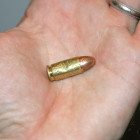

An 11-year-old denied making a threat and was allowed to return to school. Tennessee police arrested him anyway.
|
In late September, Torri was driving down the highway with her 11-year-old son Junior in the back seat when her phone started ringing.
It was the Hamilton County Sheriff’s deputy who worked at Junior’s middle school in Chattanooga, Tennessee. Deputy Arthur Richardson asked Torri where she was. She told him she was on the way to a family birthday dinner at LongHorn Steakhouse.
“He said, ‘Is Junior with you?’” Torri recalled.
Earlier that day, Junior had been accused by other students of making a threat against the school. When Torri had come to pick him up, she’d spoken with Richardson and with administrators, who’d told her he was allowed to return to class the next day. The principal had said she would carry out an investigation then. ProPublica and WPLN are using a nickname for Junior and not including Torri’s last name at the family’s request, to prevent him from being identifiable.
When Richardson called her in the car, Torri immediately felt uneasy. He didn’t say much before hanging up, and she thought about turning around to go home. But she kept driving. When they walked into the restaurant, Torri watched as Junior happily greeted his family.
Soon her phone rang again. It was the deputy. He said he was outside in the strip mall’s parking lot and needed to talk to Junior. Torri called Junior’s stepdad, Kevin Boyer, for extra support, putting him on speaker as she went outside to talk to Richardson. She left Junior with the family, wanting to protect her son for as long as she could ...

Stray Bullets Injured Hundreds in One Year, Study Finds
|
More than 300 people in the United States were struck by stray bullets between March 2008 and February 2009, often from shootings unconnected to the victims, according to a new study by researchers from the School of Medicine at the University of California, Davis. Published in The Journal of Trauma and Acute Care Surgery, the study calculated the frequency of stray-bullet shootings during an 11-month period - a phenomenon, according to researchers, that resulted in at least 317 injuries. Garen Wintemute, professor of emergency medicine and director of the Violence Prevention Research Program at UC Davis conducted the research, which was partially funded by the California Wellness Foundation and the Eli and Edythe L. Broad Foundation. Using data collected from news alert services such as Google Alerts, in addition to GunPolicy.org archives, Wintemute and his colleagues tracked stories containing the term “stray bullet” for nearly one year, ultimately counting 284 shootings in which people were injured or killed by stray bullets. The study defines a stray-bullet shooting any instance in which a bullet escapes the immediate scene of the shooting and results in the injury of at least one person either by directly striking the victim or through associated “secondary mechanisms,” such as injuries sustained from glass shattered by a bullet.

New Report Examines the Prevalence of Sexting Among Teenagers
|
According to a new report published in the Archives of Pediatrics & Adolescent Medicine , more than half of all respondents in a recent evaluation of teen “sexting” trends reported that they had been asked to send nude photos of themselves to other teens, with more than a quarter of the respondents stating that they had sent nude photos of themselves to other adolescents. The report, Teen Sexting and Its Association With Sexual Behaviors, entailed a longitudinal study involving 848 high school students in seven high schools in southeast Texas. The mean age of the respondents was 15.8, with a majority of the population consisting of 10th and 11th grade students. Researchers found that 28 percent of the sample population reported having sent a nude photo of themselves via “sext” - a sexually explicit e-mail or text message, usually sent and received via a cell phone or smart phone. An additional 31 percent of the sample population said that they had asked someone to send them a sext, with 57 percent of respondents reporting that they had been asked by someone to send them a sext.

High Court’s Decision in Miller v. Alabama is a Victory for Many, Especially in Communities of Color
|
The W. Haywood Burns Institute (BI) would like to congratulate our colleague Bryan Stevenson at the Equal Justice Initiative and the legions of lawyers, advocates and families on their victory in the U.S. Supreme Court’s decision in Miller v. Alabama.
This decision will impact more than 2,000 young people of which 75 percent are youth of color. The decision specifically holds that young people convicted of homicide cannot mandatorily be sentenced to life without possibility of parole. While some headlines scream that “murderers” will go free, for those of us that live and work in communities of color, this decision is impactful and important. In some communities of concentrated poverty across the country, the line between perpetrator and victim is easily traversed. Families of victims and convicted perpetrators are coming to grips with the facts of the new decision.

The True Horror of Youth in Solitary Confinement
|
It was an isolation cell at a youthful offender prison where I spent a lot of time, a place called Alto, in north Georgia. It was used to break young men down, and it was often where punishment beatings took place as well. Even men who weren’t beaten would eventually begin to crumble. The isolation proved too much for even the toughest of us. Sometimes when the guards opened the door to deliver food you could hear the prisoners screaming, usually begging to be let out, with promises that they would behave.

California Bucks Trend by Rejecting New Limits on ‘Solitary’
|
At the first-ever congressional hearing on the subject of solitary confinement, Sen. Dick Durbin of Illinois recently observed that it’s not always “the worst of the worst” who are subjected to the practice. Mentally-ill inmates, immigrants and juvenile offenders are put in solitary as well. And perhaps, said a series of witnesses at the hearing, the time has come to rethink the issue.




